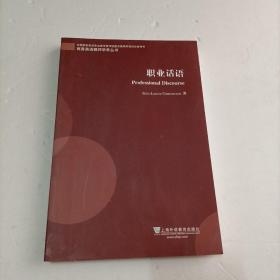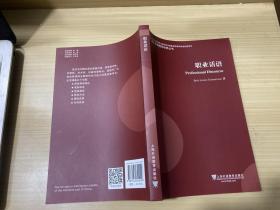
职业话语/商务英语教师学养丛书
¥ 9 2.1折 ¥ 43 九品
仅1件
重庆渝北
认证卖家担保交易快速发货售后保障
作者冈纳森 著
出版社上海外语教育出版社
出版时间2016-08
版次1
装帧平装
货号v16
上书时间2024-03-13
- 最新上架
商品详情
- 品相描述:九品
图书标准信息
- 作者 冈纳森 著
- 出版社 上海外语教育出版社
- 出版时间 2016-08
- 版次 1
- ISBN 9787544644099
- 定价 43.00元
- 装帧 平装
- 开本 16开
- 纸张 胶版纸
- 页数 275页
- 字数 464千字
- 正文语种 简体中文,英语
- 丛书 商务英语教师学养丛书
- 【内容简介】
- “商务英语教师学养丛书”是一套专门针对商务英语教学和研究的原版专著,涉及专门用途英语、商务会议英语、商务讲座英语、商务英语语言学研究等,对外语教师与研究者具参考价值。本套丛书为国内首次原版引进,具有前沿性、代表性、学术性。
- 【目录】
-
Acknowledgements
SECTION 1: INTRODUCTION
1. Introducing the topic and the book
1.1 Why is it important to analyse professional discourse?
1.2 What is professional discourse?
1.3 What distinguishes professional discourse from
other types of discourse?
1.4 What is the purpose of the book?
1.5 How is the book organized?
2. A theoretical model for contextual analysis of professional discourse
2.1 The construction of professional discourse
2.2 The contextual dependence of professional discourse
2.3 Model for the contextual reconstruction of
professional discourse
2.4 Conclusions
3. Methodology to explore the dynamic relationship between
text and context
3.1 Cognitive analysis
3.2 Pragmatic analysis
3.3 Macrothematic analysis
3.4 Conclusions
SECTION 2: SCIENTIFIC DISCOURSE
4. The socio-historical construction of medical discourse
4.1 A constructivist approach to medical discourse
4.2 Excerpts from medical articles from different periods
4.3 Stages in the development of medical science
4.4 Scientificality in medical articles from 1730 to 1985
4.5 The relationship between text and context for
scientific medical writing
4.6 Conclusions
5. Non-verbal representation in articles within technology,
medicine and economics
5.1 Theoretical background
5.2 Non-verbal representation in scientific articles
5.3 Discussion
5.4 Conclusions
6. From a national to an international writing community:
The case of economics in Sweden
6.1 The Swedish economics community over three centuries
6.2 The change from a journal in Swedish to a journal in English
6.3 Homogenization of article patterns
6.4 Discussion
6.5 Conclusions
SECTION 3: LEGISLATIVE DISCOURSE
7. The functional comprehensibility of legislative texts
7.1 Comprehension and comprehensibility
7.2 Pilot studies
7.3 Pragmatic analysis of legislative texts
7.4 Law-texts for different functioffs
7.5 Schema for function-centred analysis of laws
7.6 The alternative law-text
7.7 Test on functional comprehensibility
7.8 Discussion
7.9 Conclusions
8. The legislative writing process
8.1 Introduction
8.2 Societal constraints on lawmaking
8.3 The case of Swedish lawmaking
8.4 The legal writing process
8.5 The process and its product
8.6 Conclusions
SECTION 4: WORKPLACE DISCOURSE
9. Communication at work: A sociolinguistic perspective on
workplace discourse
9.1 A sociolinguistic framework
9.2 Communication in a local government office
9.3 Conclusions
10. The multilingual workplace: Discourse in a hospital and
a large company
10.1 Theoretical approaches
10.2 Presentation of the research project
10.3 The organizational structure of text and talk at work
10.4 Workplace languages
10.5 Foreign language users at work
10.6 Workplace interaction from a diversity perspective
10.7 Conclusions
SECTION 5: DISCOURSE IN LARGE
BUSINESS ORGANIZATIONS
11. The multilayered structure of enterprise discourse:
The case of banks and structural engineering firms
11.1 The sociolinguistic order of communication in
a close-knit working group
11.2 A model of communication in large enterprises
11.3 Presentation of the research project
11.4 Discourse in European banks and
structural engineering companies
11.5 The construction of an 'organizational self':
The case of European banks
11.6 Conclusions
12. Business discourse in the globalized economy:
A diversity perspective on company websites
12.1 The construction of an 'organizational self' on the internet
12.2 The balance between local and global concerns
12.3 The balance between economic concerns and
social/societal values
12.4 Discussion
12.5 Conclusions
SECTION 6: CONCLUSIONS
13. Professional discourse in the twenty-first century
13.1 Professional discourse in different domains
13.2 Large organizations in the twenty-first century
13.3 The multilingual workplace
13.4 Workplace discourse in the 'new work order'
13.5 Topics for future research
13.6 Conclusions
References
Index
点击展开
点击收起
相关推荐
— 没有更多了 —




















以下为对购买帮助不大的评价